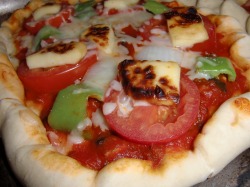
Pizza is a favorite of Americans of all ages. Here in the states, we eat approximately 11,000,000,000 slices of pizza per year. Although the style of pizzas to which we are all are accustomed are uniquely American, it may not surprise you that the concept of pizza is not an American creation. No, it's not Italian either. The origins of this savory pie can be traced back to Ancient Greece. Here, the first pizzas were flat bread with olive oil, herbs, and dates. It was cheap food for the masses. As it spread throughout the Mediterranean it adapted to each new region but remained relatively inexpensive. However, as soon as a few notable nobles acquired a taste for this treat, pizza became somewhat of a delicacy.
Legend has it that during the reign of Spanish King Umberto (1878-1900), his wife, Queen Margherita went on an inspection tour of her kingdom. After seeing many of her subjects eating this large flat bread, she ordered a guard to bring her what the peasants were having. Some could say this was the pizza delivery. The Queen loved it so much she asked for it to be served in the court. She commissioned Raffaele Esposito, a pizzaioli in Naples, to make her custom pizza. To please the Queen, he created a pizza with Mozzarella, Basil, and Tomatoes (the colors of the Italian flag) and called it a Pizza Margherita. She loved With the stamp of the Queen's approval, the Pizza Margherita became the standard pizza around the world and Naples became the pizza capital.
Legend has it that during the reign of Spanish King Umberto (1878-1900), his wife, Queen Margherita went on an inspection tour of her kingdom. After seeing many of her subjects eating this large flat bread, she ordered a guard to bring her what the peasants were having. Some could say this was the pizza delivery. The Queen loved it so much she asked for it to be served in the court. She commissioned Raffaele Esposito, a pizzaioli in Naples, to make her custom pizza. To please the Queen, he created a pizza with Mozzarella, Basil, and Tomatoes (the colors of the Italian flag) and called it a Pizza Margherita. She loved With the stamp of the Queen's approval, the Pizza Margherita became the standard pizza around the world and Naples became the pizza capital.

Pizza did not come to America until the early 1900s. The first pizzas in the United States were called "Tomato Pies." They are traditionally built with the dough, then the cheese, then the sauce and whatever else met your fancy. Once they hit the shores and moved inward, pizza changed from the traditional thin crust to the popular Chicago style deep dish.
Today, Pizza has once again become a food for the masses. As a poor, college student, I appreciate its simplicity and deliciousness. It is one surefire way to attract crowds to any meeting. College students and the rest of America consume about 350 slices of pizza per second. The most popular topping is not one that was found in Italy, but rather something that came about here, Pepperoni. In India, pickled ginger, minced mutton, and paneer cheese are favorites. The two most popular topping combinations in Japan are Mayo Jaga (mayonnaise, potato, and bacon) and eel and squid. Brazilians enjoy green peas on their pies and Russians love a red herring pizza.
One of the beautiful things about pizza is you can throw just about anything on it. When I made these pizzas, I emptied my refrigerator and used up anything that was on the verge of going bad: tomatoes, peppers, ham, mushrooms, onions...basically anything and everything. The pizza dough recipe I used is down below. It was a solid base for the toppings and sauce but I would have preferred a puffier crust.
Pizza Dough
1/2 – 3/4 c. warm water
1 T. dry active yeast
1 t. sugar
2 c. flour
1 T. vegetable or Olive oil
1/2 t. salt
1. Combine 1/4 c. water with yeast and sugar. Stir to dissolve the yeast, set aside until bubbly about 5 minutes.
2. Mix flour and salt, then add the oil.
3. Stir the yeast mixture into the flour mixture, adding water until it forms a ball you can work with. Knead for a few minutes. Cover with plastic wrap and let stand for 10 minutes
5. Put all the toppings on and bake at 350 or 375 or 425˚. Don't preheat the oven. Bake for 10-15 min or until the bottom is brown and the cheese isn't burnt.

